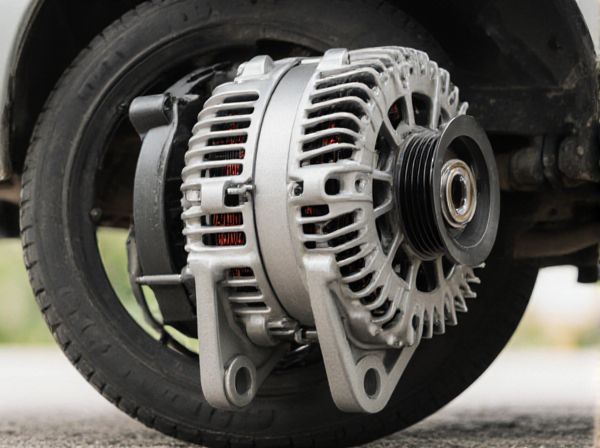
Photo illustration: Delta Winding vs Wye Winding
Delta winding offers a closed-loop configuration ideal for high starting torque and better phase balance in three-phase systems, enhancing your motor's performance in heavy-load applications. Wye winding provides a neutral point for grounding and allows for dual voltage operation, making it suitable for flexible power distribution and safer electrical installation. Choosing between Delta and Wye winding depends on your specific load requirements and system design preferences.
Table of Comparison
| Feature | Delta Winding | Wye Winding |
|---|---|---|
| Voltage Output | Lower line voltage, suitable for heavy loads | Higher line voltage, ideal for long-distance transmission |
| Current Rating | Higher line current capacity | Lower line current capacity |
| Fault Tolerance | Continues operation despite a single winding fault | More sensitive to winding faults |
| Neutral Availability | No neutral point | Neutral point available for grounding |
| Efficiency | Higher copper utilization, good for high current applications | Better voltage stability, efficient under balanced loads |
| Typical Use in Cars | Common in heavy-duty alternators | Used in lightweight and passenger vehicles |
Introduction to Delta and Wye Windings
Delta winding features a triangular configuration where each coil is connected end-to-end, forming a closed loop that allows for balanced three-phase power distribution. Wye winding arranges coils in a star shape, connecting one end of each coil to a common neutral point, facilitating different voltage levels and improved system stability. These winding types are fundamental in transformer design, influencing voltage transformation and load characteristics in electrical power systems.
Basic Structure of Delta and Wye Connections
Delta winding features a triangular configuration where each coil end connects to form a closed loop, enabling three-phase currents to circulate in a continuous path without a neutral point. Wye winding arranges coils in a star shape with one end of each coil connected to a common neutral point, providing a neutral wire for grounding and load balancing. The structural difference impacts voltage levels and fault tolerance, with delta offering line-to-line voltage and wye providing line-to-neutral voltage.
Key Differences Between Delta and Wye Windings
Delta winding features a closed loop configuration where each phase is connected end-to-end, enabling higher line currents and better handling of unbalanced loads. Wye winding connects each phase to a common neutral point, providing a neutral for grounding and allowing the use of both phase-to-neutral and phase-to-phase voltages. Delta windings typically offer higher starting torque and are suitable for power transmission, while Wye windings provide multiple voltage levels and improved system stability.
Advantages of Delta Winding
Delta winding offers higher starting torque and better phase load balancing compared to wye winding, making it ideal for heavy-duty motors. It provides a closed path for third harmonic currents, reducing voltage distortion and enhancing system stability. The configuration allows for continued operation when one phase is interrupted, ensuring improved reliability in industrial applications.
Advantages of Wye Winding
Wye winding offers a neutral point, enhancing system stability and allowing for easier fault detection in electrical networks. It provides the capability to supply both phase and line voltages, which improves versatility for various load types. Wye configurations also reduce insulation requirements due to lower phase voltage compared to delta connections, resulting in increased safety and cost efficiency.
Applications of Delta Winding
Delta winding is widely used in industrial applications requiring high starting torque and robust performance, such as in heavy-duty motors and transformers supplying three-phase power. It offers a stable voltage supply under unbalanced loads, making it ideal for manufacturing plants and large HVAC systems. The closed-loop configuration of Delta winding also enables continuous operation even if one phase fails, ensuring reliability in critical operations like mining and steel production.
Applications of Wye Winding
Wye winding is widely used in power distribution systems due to its ability to provide a neutral point, allowing for multiple voltage levels and stable grounding. It is essential in three-phase transformers supplying both single-phase and three-phase loads in residential, commercial, and industrial applications. The configuration enhances system safety and reliability by facilitating fault detection and balanced load distribution.
Comparative Analysis: Efficiency and Performance
Delta winding offers higher starting torque and better fault tolerance, making it ideal for heavy-load applications where efficiency under variable loads is crucial. Wye winding provides more stable voltage levels and lower line currents, resulting in improved energy efficiency and reduced losses during steady-state operation. Performance-wise, delta configurations excel in power factor correction, while wye connections typically achieve smoother motor operation with lower harmonic distortion.
Factors to Consider When Choosing Between Delta and Wye
Choosing between Delta and Wye winding configurations depends on factors such as the desired phase voltage and current, system grounding requirements, and load balancing characteristics. Delta windings provide higher phase currents and better fault tolerance, making them suitable for heavy industrial loads, while Wye windings offer a neutral point for grounding and enable use of multiple voltage levels, ideal for distribution systems. Consideration of power quality, insulation levels, and transformer connection compatibility also plays a crucial role in selecting the appropriate winding.
Conclusion: Delta vs Wye Winding
Delta winding offers higher starting torque and is ideal for heavy load applications due to its ability to provide a stable and balanced power supply under high current conditions. Wye winding delivers better voltage stability, reduced insulation stress, and lower starting current, making it suitable for light to medium load operations and energy-efficient systems. The choice between delta and wye winding depends on the specific load requirements, operational efficiency, and voltage considerations of the electrical system.
 caratoz.com
caratoz.com